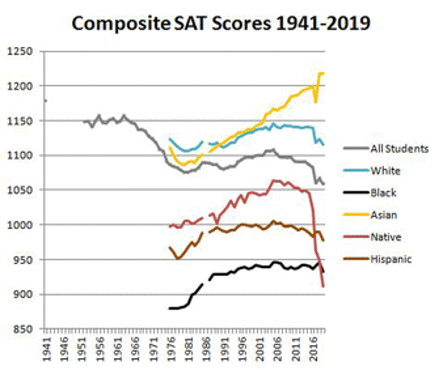“The mediocre teacher tells. The good teacher explains. The superior teacher demonstrates. The great teacher inspires.”
William Arthur Ward
The cause of the problem
We all want our children to live fulfilling lives. We want them to realize their dreams of a better future for themselves, their families, and our nation. However, to accomplish these goals, we must provide them with opportunities that can enable them to create their future. The key factor that will limit their ability to create their future is the severe decline in the quality of our K-12 education system, especially the teaching of science, technology, engineering, and mathematics (STEM) subjects. This decline has affected the preparedness of our young people to adapt to a continuously changing and highly competitive world. By allowing this to happen over time, we have put their future and our nation’s future at significant risk.
The decline in our K-12 education system began in the early 1980s. The fundamental cause dates back to university policies that transformed the teaching of STEM courses to aspiring STEM teachers that had little connection to the traditional departments that teach these subjects. This transformation created separate courses such as physics for poets, chemistry for poets, biology for poets, etc., which did not include mathematics in the teaching of these subjects. If a teacher has not struggled with the conceptual problems in learning these subjects, it is virtually impossible to teach them to students effectively. How this training could be effective in inspiring and educating our youth in these fields is incomprehensible.
Our young people are not stupid. They sense when a teacher does not understand a subject and are uninspired by teachers who do not have a passion for the subjects they teach. Today, the majority of K-12 STEM teachers believe their responsibility is to provide students with information. This approach is not teaching. Today, many K-12 STEM teachers fulfill their lesson requirements by primarily reading from scripts. The proficiency of these teachers is so low that it would not take much to replace them with technology, which is a subject that I will return to later.
This transformation in the training of teachers increased university enrollments and, along with it, revenue, which satisfied administrators; however, it also dramatically increased the number of poorly trained STEM teachers. Over the decades, this form of training flooded our K-12 school system with incompetent teachers. Labor unions and school administrators now protect these teachers. Both university presidents and teacher unions have literally wasted our youth in the name of revenue and job security. There may have been good financial reasons to adopt these policies at the time, such as the need for increased revenues during an economic downturn. However, our nation is paying a considerable price in terms of a future workforce ill-equipped to compete in a highly competitive high-tech world.
Our nation led the digital, communication, and biotechnology revolutions. Yet, we lack enough qualified US citizens to compete for jobs in these industries. Ironically, we now have to import expertise to fill these jobs, which our government has enabled through special immigration programs. Such a strategy takes pressure off our K-12 education system to improve STEM education standards.
This circumstance affects our people over the long-term, especially in a world that puts increasing emphasis on STEM skills in numerous occupations. Unless this trend is abated, our education system will create a permanent underclass in our nation that will become increasingly dependent upon public assistance for their survival.
There is now a call by certain politicians to increase public school teacher salaries as if this is a solution to the poor quality of our K-12 education system. Such salary increases could indeed attract those who typically go into STEM-related industries; however, to be effective, the proficiency standards of STEM teachers would have to change significantly. This expedient salary approach to fixing this serious problem is a sinister way that politicians use taxpayer dollars to secure more votes by pandering to the public. These are the same politicians who protect incompetent teachers through their support of teacher unions instead of focusing their attention on protecting the future of our youth and our nation.
Basic facts and consequences
By far, the most important educational challenge we face as a nation is to realize a K-12 educational system that prepares our youth for the future. Our young people will have to be at least as creative and productive as those that will be retiring over the next several decades. Through the skills they develop, the new knowledge they acquire, and the talents they bring to our national enterprise, their future will be our nation’s future.
As obvious as this sounds, we are a nation that spends less time thinking, planning, and investing in our future, especially human potential that inevitably drives everything in our national enterprise. As the challenge of adequately preparing our youth becomes dire, people will focus more on quick fixes. Rather than pursue productive social pathways for themselves, our youth will find government subsistence a more attractive option. Such a path will inevitably result in a public that is no longer in control of their destiny but controlled instead by a massive government bureaucracy.
The list of educational reform proposals and policies for our K-12 system is quite long. Still, none address the fundamental problem of educating our youth in a rapidly evolving world that is increasingly dependent on mastering STEM subjects. It’s not a matter of everyone becoming a scientist, engineer, or mathematician. Science and technology are transforming everything we do through their incorporation into the numerous processes and services we use daily. Failing to keep up with the latest technology improvements could mean the end of a business or job. It could also mean failure to defend our nation against future threats. To meet the challenges of an uncertain future, we need a workforce that embraces science and technology instead of one that fears or avoids it.
Unfortunately, our culture has changed as a result of a series of decisions made over 50 years. As discussed earlier, some of this has to do with the systematic decline in federal government R&D spending as a percentage of GDP by 65 percent since 1965. Concurrently, research jobs in the private sector have largely disappeared. These trends have sent a message throughout our educational system that careers in advancing science and technology through research are not as important as they once were. Making matters worse, qualified STEM teachers are in short supply primarily because they are inadequately trained, and those who are knowledgeable in STEM fields can find better-paying jobs. Exacerbating this situation is a lack of strong dynamic leadership with a vision that can lead our educational system to adopt new standards and methods of teaching to meet the challenges of the 21st century. Until government policies and educational leadership change, there will be little, if any, progress in improving our K-12 education system.
There are about sixty million young people in K-12 education, with about 10 percent in private schools. The case is often made that private schools are less costly per student ompared to public schools. This claim is valid for religious-based private schools. For non-sectarian schools, the cost per student is more than twice that of other private and public schools. Even if private schools were superior educational institutions, not everyone wants to send their child to a religious school, and the vast number of American families cannot afford to send their children to non-sectarian private schools. Therefore, private schools are largely irrelevant to educating the vast majority of our precious youth.
Many complain that the federal government spends too much money on education. This claim was never true. Local governments have primarily supported education throughout US history. There have been short-term blips where the federal government increased education spending after WWII through the GI Bill and during the1960s with President Kennedy’s initiative to expand the accessibility of education to people from all walks of life. However, the federal government has generally been a minor player, while local and state governments have predominantly funded education.
Local governments have created disparities in the quality of education through local real estate taxes. If there is a reason for gross inequities in our educational system, this is it. Families that live in wealthier neighborhoods receive a better-quality education than those living in impoverished areas. It’s hard to imagine how a strategy like this is of benefit to the entire nation. Education is an investment in our youth, which benefits the whole nation and not just a local community. Just imagine improving the retention level of knowledge and skills of about sixty million young people across the nation by about 20-30 percent. That could have an enormous impact on our future through the sheer number of people and the magnitude of the improvement. Asking the federal government to solve this problem would be a big mistake because the House of Representatives is district-based, and the Senate is state-based. Also, having a highly educated public is more of a threat to politicians than a benefit. As I will discuss later, a more equitable approach to education for our youth can be achieved through technology.
There is the claim that the US spends more on education per student per year than any other nation. This claim depends on how this spending is compared across countries. For example, using a nation’s GDP as the comparative measure of education spending eliminates unstable foreign currency conversion rates to US dollars. It also represents the monetary value of all US goods and services produced, which is a measure of what we can afford to invest in education.
Comparing what we spend on all education as a percentage of our GDP, about 6.4 percent, to that of the 35 countries in the Organization of Economic Cooperation and Development (OECD), implies that we are tied for 5th place with Iceland while the United Kingdom is close behind us in 6th place. New Zealand, The Republic of Korea, Norway, and Israel spend more of their GDP on education. We are below the OECD average for K-12 but place first by substantial margins in post-secondary school education.
In terms of outcomes, if you look at US high school dropout rates from the 1960s to the present, there have been significant reductions across all racial and ethnic groups by about one third relative to their historical levels. Just looking at this alone, one might conclude that there has been significant progress.
However, according to our Nation’s Report Card, the proficiencies of K-12 students in subjects like civics, economics, geography, mathematics, reading, science, technology and engineering literacy, US history and writing are all in steady decline. There is no subject at any grade level, where the percent proficiency of students is 50% or more. Astonishingly, the proficiency percentages range from about 40% down to about 10%, depending on the subject and grade level. And instead of improving from lower to upper grades, the percentages systematically decline in all subjects. You can, of course, question the accuracy of these numbers, how they were measured, differences between schools, and deny that there is even a problem, but the overall trends from year to year should be of considerable concern. Some would call this a crisis in K-12 education.

We can gain further insight into this by examining the percentage of high school seniors who met college readiness benchmarks. In 2011, 52% did not meet reading levels. Only 45% were proficient in math and 30% in science. These numbers indicate a significant disconnect in readiness standards between our nation’s high schools and colleges and universities. You can see this in SAT scores over time as indicated in the figure to the left for all students with the exception of Asians. The State of California has decided to solve this problem by eliminating the exams all together. It’s hard to imagine how this helps anyone except those who are doing a very poor job in improving K-12 education. This situation has forced our colleges and universities into providing remedial education in high school subjects. It is not solely a consequence of high school standards, but also the teaching methods and the proficiency of the teachers that teach these subjects. This is irrefutable.
As further evidence, the percentage of students taught by teachers with no major and no certification in core subjects is quite shocking. They range from 30% in math, 61% and 66% in biology and physics, respectively, 79% in earth and space science. Rather large percentages of our youth are being educated by the uneducated. Given these circumstances, it is not difficult to imagine that such teachers fail to inspire confidence or enthusiasm in students that are learning these subjects. It should also be no surprise that less than 15 percent of the top-performing high school seniors major in STEM fields. At this rate, our nation will not meet the future demand for jobs in these fields. Ironically, this situation has required the U.S.to import talent to meet the shortfalls in qualified people for the high-tech sector.
In traveling around the world with about one and a half million miles to my total, once in a while you can get lucky. On a flight from Washington DC to San Diego, I managed to sit next to a former Secretary of Labor. After introducing myself, I mentioned the decline in US citizens going into STEM fields and whether the Labor Department was concerned. To my surprise, I was told there would be plenty of qualified people available through students coming to our nation from outside the US. As is typical, government agencies have narrowly defined policies that serve the purpose of promoting their existence rather than having a coordinated plan across the government that effectively addresses the systemic issues of a significant national problem.
This immigration policy accommodates a K-12 educational system that has failed. It is also creating a permanent underclass of unskilled workers in our nation. Furthermore, this trend will also create a national security risk because U.S. citizens in STEM fields are needed in critical defense areas that require high-level security clearances.
The future of our precious youth has, in effect, become expendable by incompetent teachers, teacher unions, and politicians. When you bring this up with the believers in the system, they simply blame the parents. As a result, we are now in the business of wasting human potential.
An inevitable solution to K-12 education
Solving this problem involves replacing the current system over time with a new paradigm of K-12 education. As typical, any person or organization attempting to change the current system will be confronted by fierce opposition. Any change to the classroom model of teaching, which dates back more than two thousand years to Ancient Greece, is unacceptable. However, absent a radical change in the current system, our future as a nation will very likely provide fewer opportunities for our youth to achieve a fulfilling life in our society.
To start along a path of change, imagine an ideal school for maximizing student performance. Through a carefully crafted selection process, this school would select from a diverse population of students those with comparable learning capabilities. Having students with comparable learning skills enables the training and learning process to be more efficient in maximizing student performance. In contrast, a standard classroom compels a teacher to teach to the middle of the student capability distribution. This conventional approach causes inefficiencies in maximizing student performance on either side of the middle of their learning capability. You lose the students that need more help and those that are more capable of learning become bored.
For such a school, teachers would be required to be proficient in the subjects they teach and have a demonstrated passion for teaching. The school would also have diversity in sports, music, the arts as well as community activities. Students at the appropriate age would be encouraged to participate in school governance to gain an appreciation of leadership. There would also be tests and competitions to measure and promote excellence. Naturally, there would be winners and losers. Through these standards and types of activities, such a school would develop students with strong character and intellectual, emotional, and social intelligence.
There are costly private schools that emulate such a model. Some would object that diversity is limited in such a model because it selects students of comparable learning capability. The problem is that there are inherent limitations of developing individual performance in a standard classroom versus being selective by teaching students of comparable learning capability to maximize their performance. Fortunately, technology can overcome these limitations through the development of human-specific learning and training.
Through the integration of several existing technologies, human-specific training and learning could be made accessible to anyone. This approach would enable each individual to maximize his or her performance at a rate specific to them. With steady advances in AI, machine learning, computer processing, and virtual reality environments, human-specific training and learning will improve. This approach to education would level the playing field by providing equal opportunity for all to obtain a decent education.
For several decades now, we have known that children have a natural affinity for computers and related information-based technologies. We also know that they enjoy single and multiplayer games. These provide risk and reward environments that challenge their skills, both physically and mentally. They are primarily rule-based and role-playing competitions with specific goals that, if achieved, can provide emotional rewards. Realistic graphics supported by a storyline with dynamic visualization can create emotionally exciting immersive environments that engage young people.
We know from Hollywood storytelling that movies that generate emotion are the most memorable. We can recall a movie and even scenes from just recognizing the musical score. We also know that intelligence and emotion are intertwined in the human brain through both behavioral and neurological studies. This fact opens up an opportunity to exploit Hollywood storytelling, realistic graphics, and gaming technology to create learning environments that increase retention through dynamic visualization of stories based on knowledge and communication using spoken language.
This approach requires the introduction of some new elements into traditional pedagogy. These elements involve the integration of Hollywood storytelling, realistic graphics, gaming technology, and critical subject matter concepts that would provide a stimulating and interactive learning and training environment. The system would have a software-driven director and intelligent tutor that assesses individual learning and training proficiency and, if necessary, adjusts the path to proficiency to match the specific individual. Natural language processing and dialog management between the student and the system would be used to enable real-time feedback. Cultural and age-specific differences could also be made a part of the learning and training experience. For STEM subjects, this would have to be supplemented by hands-on training by students conducting actual experiments along with data analysis, so they have a complete experience.
For example, about nineteen years ago, I was tasked by the Army Chief of Staff, General Eric Shinseki, to create a unique STEM competition for our nation that was specific to middle schools. The goal was to make this competition inclusive by engaging students from all backgrounds by focusing on subjects that middle school students thought were cool. In formulating this competition, surveys of seventh- and eighth-grade students and teachers were conducted at several representative schools across the nation to determine age-related student interests. Our work indicated that sports and recreation, environment, health and safety, and arts and entertainment were the dominant areas of interest for seventh and eighth graders. Of course, one might ask: “What do these interests have to do with STEM fields?” The answer is “everything” because STEM fields have played a significant role in creating and advancing these human activities.
This new competition, eCybermission, focused on these principal themes and has been tremendously successful over the last 18 years. Students from all social strata have participated in numerous small teams in all 50 States, US territories and possessions with projects in these four areas. One of these teams even received a national award from the President of the United States. From this competition we learned that age-specific interests could increase relevancy and encourage student interest in STEM subjects.
These features can all be a part of learning and training environments for academic subjects that come alive through virtual reality. Rather than reading about history or listening to it described in a classroom, it can be experienced through storytelling and visualization. Significant events in history, those who made history, battles won and lost, scientific, engineering and mathematics discoveries, and other subjects could all be visualized through a virtual reality environment with an emphasis on when it happened, how it happened, and the lessons learned. Instead of listening to abstract discussions of mathematics and physics in a classroom, these subjects can be presented through an adventure story with challenges that can be solved by employing subject matter rules and principles just like games young people enjoy playing today.
By exploiting artificial intelligence that learns, the training and learning environment can be made adaptive to the characteristics of the student. The system could dynamically adjust by providing alternative learning paths using a set of skill metrics to identify deficiencies during learning and training sessions. Using experts who understand the conceptual and process problems students typically have in these subjects, the learning and training environment can be designed to focus on overcoming these challenges with immediate reinforcement through inspiring messages that acknowledge progress. In this way, the persistence that young people exhibit in playing games can be utilized to win at learning and training.
This approach can be taken one step further through interactive assessments using natural language processing and dialog management, so the student can ask personal performance questions of the system, which can then provide recommendations on ways to improve on the educational experience. In essence, the system would have a built-in intelligent coach. The retention and mastery of a wide range of academic subjects will increase by making the experience of learning and training immersive, emotional, and human-specific. What is more, progress in learning and mastering a subject becomes a more focused and dynamic experience between the immersive environment and the student.
The only limitation to succeeding with this approach will be human imagination in realizing the types and nature of these environments. And the enormous customer base will drive down costs over time to make them affordable. What is more, technology will only improve with time, making the experience more entertaining, realistic, and enjoyable for learning and training.
To develop this system will require leadership that brings together those gifted and talented individuals representing the various disciplines needed to create these environments. Developing this is far from a simple task because of the diverse professional cultures involved and the balancing of inputs to accomplish the goal of creating an effective learning and training environment. However, there are no fundamental obstacles to achieving this.
Like most new ideas, the major obstacle will be the entrenched interests of the status quo. To achieve this will necessarily involve risk-taking and a willingness to oppose a failed educational system, which so many out of complacency depend on for their children. If we do not change our K-12 education system, we will continue to reduce social pathways to the future for our precious youth. Changing this is only a matter of recognizing the urgency, and that urgency is their future and the future of our nation.


